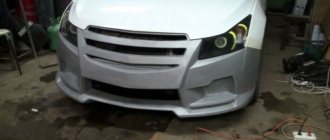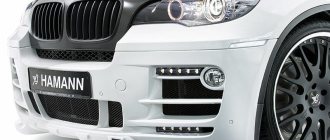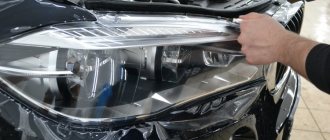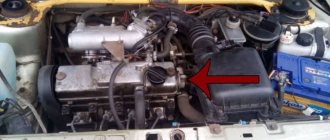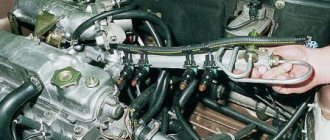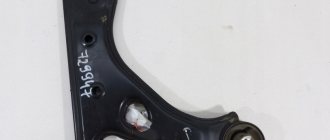Full galvanization of the car body: truth or advertising tricks of manufacturers?
Not only users, but also many manufacturers are interested in protecting the car body from corrosion.
Some of them are trying to increase the cost in this way, while others really care about the durability of the body and produce the most corrosion-resistant cars. Both of them use the same phrase “car with a galvanized body” in the description of the model. However, one should not always assume that such a characteristic really guarantees complete protection of machines from rotting. Some European manufacturers actually produce their cars with a fully galvanized body. The rest, if they use galvanizing, do it in a slightly different form - basically it is a partial treatment of some car body parts with zinc-containing compounds and more often only on one side.
Body galvanizing methods
To understand how things really are, you must first become familiar with the three well-known methods of galvanizing metal elements of car bodies.
European manufacturers, which belong to the largest concern VW Group, use the most reliable body treatment - thermal galvanization. This type of anti-corrosion treatment is very labor-intensive and expensive, which is why cars are somewhat more expensive compared to other models. More details about this method and about car models with fully galvanized bodies will be discussed below.
A simpler treatment of car bodies is galvanic galvanization, which is used both for complete processing and for protecting only the most vulnerable parts. Such elements include the bottom, arches, sills. Partial processing is used on budget car options that are intended for mass sales. Very rarely, but still used to protect metal from corrosion at home, but self-treatment with this method is only possible for small elements of the car body.
The last way to protect metal is cold galvanizing. This method is very similar to the previous one, but simpler and cheaper. It is used mainly for local processing of some car body elements at home. This galvanization is performed without immersion in a container - a zinc-containing solution is applied to the metal surface using an electrode connected to the positive terminal of the power source. The metal itself is connected to the negative terminal. Since this method is not used by car manufacturers, it is not worth describing it in more detail.
Cold galvanizing
The last method is cold galvanizing. This method is similar to the previous one in technology, but this one is even simpler and cheaper. Some car owners can process body parts using this method in their garages. The car does not need to be immersed in a special zinc-containing solution for this. The solution itself is applied to the body using an electrode, which is connected to the positive terminal (the car body is connected to the negative terminal). Some car repair shops offer a service for processing car body parts, but complete processing cannot be done this way. Since this method is not used by car manufacturers, it is not worth describing it in detail.
Thermal galvanization
This method, as already mentioned above, is used only by large manufacturers of European foreign cars. Thermal galvanization involves completely immersing the entire body in a special solution before assembling the cars. For this purpose, large technical containers are used, which are filled with a zinc-containing composition. After immersing the body, the composition warms up to the required temperature, which helps to securely attach the zinc particles to the metal surface.
As a result of the procedure, a thin film is created on the metal surface, which prevents the penetration of moisture and the destructive process of oxidation. The most corrosion-resistant cars treated with this method show the best results in salt chambers.
The manufacturer himself often gives a truly long warranty on the body. Sometimes the indicators reach up to 30 years. The minimum service life of such vehicles is about 15 years.
Which machines undergo full heat treatment at the assembly stage? Unfortunately, there are not so many of them. Not every manufacturer can afford this galvanizing method while maintaining its position in the market. Therefore, the list contains the following car brands from European industry giants:
- Audi. This manufacturer is considered a pioneer in the field of full body galvanization. Their first car with a galvanized body was produced in the early 80s. Since then, Audi has been a world leader in this field, which is why their cars with fully galvanized bodies are considered the most durable. They rarely require major body repairs. Basically, this is required only after serious accidents;
- Porsche. For this brand, quality has always come first. And one of the main ways to confirm this quality, the company considers the full treatment of the bodies of some of its models with thermal galvanization. The first car of this company with a body completely coated with zinc was the Porsche 911;
- Volkswagen. He has also been practicing thermal galvanization of the entire body for many years. It is rightfully considered one of the most durable brands among middle-class cars;
- Seat. Another option for middle-class cars that undergo full galvanization. At the same time, the price of their products remains at a quite tolerable level, which together sets them apart from their competitors.
In addition, we can note some other models of the European automotive industry that are processed by thermal galvanization:
- Some Ford Sierra models;
- Ford Escort;
- Latest Chevrolet Lacetti models;
- New models of Opel Vectra and Astra.
Of course, all of these cars have a slightly higher cost compared to their competitors. However, if you take into account the costs of subsequent body repairs, then their price is fully recouped. In addition to the cost of money, you should take into account the loss of time that will be needed for periodic patching of metal and constant touch-up of traces of corrosion. If the treated car will serve without problems for more than fifteen years, then a regular body will have to be cleaned of traces of corrosion and tinted several times.
Galvanic galvanization
A technically simpler treatment is galvanizing car bodies using the galvanic method. What are the indicators of this method? Cars treated with this method also have a fairly long warranty from the manufacturer against the occurrence of through corrosion.
Bodies galvanized by the galvanic method have a slightly lower cost than those that have been subjected to heat treatment. The same can be said about the durability of the protective layer - it lasts much less.
The galvanizing procedure is as follows:
- the part or the entire car body is immersed in a container with an acidic zinc solution;
- the negative terminal from the DC source is connected to it;
- the capacitance itself is connected to the positive terminal.
What results does this give? A process called electrolysis occurring in the container helps to securely attach dissolved zinc particles to the metal surface. The result is the formation of a reliable protective layer that repels moisture and prevents oxidation of the metal. This method is slightly cheaper than the previous one, therefore cars with this treatment are slightly lower in price.
What brands of cars are on the market with this treatment? There are also few of them - among the leaders are the auto industry giants Mercedes and BMW. These manufacturers use combined protection, which includes not only galvanizing, but also the selection of special steel. In addition, German leaders in this field use a fairly impressive thickness of paint coating as additional protection. This solution allows them to make the cost of the body at an acceptable level to make a profit. And at the same time, such protection is no less effective than Audi methods developed over the years.
Partial galvanization of cars or simply a publicity stunt
In conclusion, we should consider those brands that use only partial treatment of the body of their cars, passing it off as full galvanization. What brands use this advertising ploy? Here you can find brands of Korean, Chinese and even domestic production.
For example, as for the domestic automotive industry, the latest Lada models are subject to partial processing. These include Kalina and Granta, which recently, according to the manufacturer, are coated with a protective layer of zinc by almost 40%. In these cars, only the bottom, sills and arches are completely galvanized.
In this case, only one-sided galvanization of some body parts is used. The second side is simply primed and painted in the traditional way. Such protection is designed to ensure that the part of the body hidden from view will be reliably protected from unnoticed rotting.
This approach allows you to significantly save money on production lines and make good advertising for your products. And although corrosion protection is still present on such cars, its capabilities are often exaggerated for advertising purposes, passing it off as full-fledged galvanization with the help of competent text. Such manufacturers also include Hyundai, Chery, Geely and Kia. Moreover, the latter brand often uses conventional cataphoretic priming with the addition of zinc particles. Such protection is also very effective, but it cannot be compared with the treatment that cars of European brands are subjected to.
Japanese automobile products have been showing good results lately. Here the Honda brand is considered the leader. It is also worth noting some successes in this area among new Toyota cars. Their technology, of course, is far inferior to the European giants of the automotive industry. However, cars of these brands also have a long warranty on the body and show good protective properties when tested in a salt tunnel.
The only drawback of such manufacturers is that they are overly loud about the protective properties of their products. In order not to fall for the bait of advertisers, it is necessary first of all to pay attention not to the words with galvanization, but to the length of the warranty period for the body. This indicator is more reliable and truthful than any general statements about high-tech metal galvanization.
Foreign cars
As for foreign cars, galvanizing of car bodies began many years ago. Look how many foreign cars still drive on our roads, despite the fact that more than 20 years have passed since the car was produced.
Audi A6
The premium division of the Volkswagen concern, which produces cars under the Audi brand, was historically the first in the world to use full hot-dip galvanization of bodies.
There is even a myth in Russia that the three letters ZZZ in their VIN numbers mean “triple galvanizing.”
This is nothing more than a legend, but the machines are truly fully protected using the best hot-dip galvanizing technology. And the matter is not limited to a multi-year warranty on the body; cars continue to resist rust even after its formal end.
Volkswagen Golf
These cars, regardless of generation, are considered one of the most reliable, which is supported by the same methods of protecting body parts from corrosion.
Despite the lower class of cars, their reputation is no worse than that of Audi. Double-sided zinc protection is applied to all parts; the bodies are not afraid of damage to the paintwork.
Opel Astra, starting from generation H
The company took a responsible approach to criticism of its cars from early years of production regarding the premature appearance of through corrosion. Full double-sided galvanization was introduced in stages, on the last Vectra C machines, and then on Astras.
At the same time, the body warranty was significantly increased. By its size one can judge the degree of protection. The company traditionally does not provide exact information, although it is known that this is a hot two-way method.
BMW and Mercedes
These companies use a galvanic type of zinc coating of bodies. The method is not the most perfect, but it leads to good results, since these companies combine it with the use of special steel for bodies, which is initially resistant to corrosion.
The premium nature of the brands ensures the same level of protection for all models, regardless of their class.
Chevrolet Lacetti
The car is far from the most prestigious and expensive, but at the behest of the manufacturer who took a responsible approach to quality, the body was fully galvanized.
The result is known to the owners - a cheap car, contrary to expectations, does not rot. A good example for many other brands.
To summarize, we can conclude that today, almost all new cars have a galvanized body, in some places it is done with high quality, in others it is only partially processed. Another thing is that manufacturers provide a guarantee on the operation of components and mechanisms for a period of no more than 5 years, and during this time the body certainly should not rot.
What is galvanizing
On unprotected metal, an oxidation process occurs. Oxygen penetrates deeper and deeper into the metal, gradually destroying it. Zinc also oxidizes in air, but a protective film forms on the surface. This film prevents oxygen from penetrating inside, stopping oxidation.
Galvanization of car body
Thus, the zinc-coated base is perfectly protected against corrosion. Based on the processing method, a galvanized body can last up to 30 years.
Reference. AvtoVAZ began to use partial galvanization of the body only in 1998.
Partial galvanization
Many manufacturers use only partial galvanization, passing it off as full. This applies primarily to Chinese and Russian brands, as well as some Korean ones and Lada Kalina are partially galvanized. The bodies of these cars are covered with a protective anti-corrosion layer of 40%, but this is not bad either. Here the thresholds and the bottom of the car are treated with an anti-corrosion compound. In this case we are talking about one-sided galvanizing. The second side (inner) is painted and primed using traditional methods.
This approach allows manufacturers to save money and produce budget-class cars designed for mass buyers. But this does not stop people from talking about anti-corrosion treatment in commercials, because it really does take place.
Technology and types of galvanizing
The main condition for galvanizing is a clean and smooth surface that will not be subject to bending or impact. Several processing methods are used in the automotive industry:
- hot galvanized (thermal);
- galvanic;
- cold.
Let's consider the technology and the result of each method in more detail.
hot
This is the most reliable and best type of galvanizing. The car body is completely immersed in a container of molten zinc. The temperature of the liquid can reach 500 C°. So pure zinc reacts with oxygen to form zinc carbonate on the surface, which stops corrosion. The entire body is coated with zinc on all sides, including all joints and seams. This allows automakers to provide a body warranty of up to 15 years.
Hot galvanized
In other areas, parts treated in this way can last 65-120 years. Even if the paintwork is damaged, the zinc layer begins to oxidize, but not the metal. The thickness of the protective layer is 15-20 microns. In industry, the thickness reaches 100 microns, making parts almost eternal. Also, scratches during hot processing tend to heal themselves.
Audi was the first to use such technology on the Audi A80. Later this method was used by Volvo, Porsche and others. Despite the high cost of hot galvanizing, the method is used not only on premium cars, but also on budget models. For example, Renault Logan or Ford Focus.
Galvanic
In the electroplating method, zinc is applied to metal using electricity. The body is placed in a container with zinc-containing electrolyte. This method allows you to save on substance consumption, since zinc covers the metal with an absolutely even layer. The thickness of the zinc layer using the galvanic method is 5-15 microns. Manufacturers provide a guarantee of up to 10 years.
Since galvanic treatment protects less well, many manufacturers improve the quality of the metal, thicken the zinc layer and add a layer of primer.
This method is used by brands such as Skoda, Mitsubishi, Chevrolet, Toyota, BMW, Volkswagen, Mercedes and some others.
Reference. Since 2014, UAZ has been using galvanic coating on its Patriot, Hunter, and Pickup models. Layer thickness 9-15 microns.
Cold
This is a simple and inexpensive way to protect the body from corrosion. Used on many budget models, including Lada. In this case, highly dispersed zinc powder is applied by spraying. The zinc content on the coating is 90-93%.
Cold galvanized body
Cold galvanizing is widely used by Chinese, Korean and Russian automakers. Partial cold galvanizing is also often used, when only part of the parts or only one side is processed. Then corrosion can begin, for example, from the inside, although the car itself looks good outwardly.
Pros and cons of galvanizing methods
Each of the described methods of applying zinc protection has its own pros and cons.
- Hot-dip galvanizing provides excellent protection, but an even layer cannot be achieved. Also, the color of the coating is gray and matte. You can see zinc crystals.
- The galvanic processing method protects a little less well, but the part turns out shiny and smooth. It is also beneficial from an economic point of view.
- The only advantage of the cold processing method is that it is cheap, but this is only good for manufacturers, although it allows the price of the car to be reduced.
How to find out whether a car body is galvanized or not?
If you want to find out whether the body is zinc-treated or not, then the first thing you should do is look at the technical documentation of the car. If you didn’t see the word “zinc” there, then there is no protection against corrosion. Although most automakers use galvanizing, the only question is the method and area of processing. For example, until 2008, only 28% of the body on the Lada Priora was galvanized; on the VAZ 2110, only 30% of the body was galvanized. And this is with the cold processing method. Chinese manufacturers often save on zinc processing.
You can also search for information on the Internet on reputable resources. You can find many tables. You can see one of these at the end of this article.
If you see the phrase “full galvanization,” then this indicates a galvanic or hot method of processing the entire body. This base will last for many years without corrosion.
Some popular models with galvanized body
As already mentioned, full galvanization is also used on many budget models. Next, we will present to you some very popular car models with anti-corrosion coating in Russia and abroad.
- Renault Logan The body of this popular brand resists corrosion well. Since 2008 it has been fully galvanized.
- Chevrolet Lacetti . An inexpensive car, but with a completely anti-corrosion coating. Galvanic treatment was used.
- Audi A6 (C5) . Even 20-year-old cars in this class look good, largely due to the full galvanization. The same can be said about all Audi cars. This manufacturer uses hot-dip galvanizing.
- Ford Focus . A real people's car with good anti-corrosion protection. All bodies in this line were processed using the hot method.
- Mitsubishi Lancer . A strong and reliable car that is loved in Russia and abroad. It does not rust due to the 9-15 micron thick zinc coating.
Galvanized car body - list of brands and models
Conversations that complete galvanization of a car body will have a beneficial effect on its service life and keep it liquid for perhaps even more than a dozen years began in the 80s. It was then that the Audi concert (already part of the Volkswagen Group) presented the first Audi 80, the body of which was completely hot-dip galvanized. It is considered the first among cars of the so-called “popular” level, since the very first was the Porsche 911 sports car. What did thermal galvanization look like and what does it represent? Thermal galvanization of a car body is the most reliable protection against corrosion and is used by all major automakers to create sustainable protection for the body of serial and small-scale cars. The photo above shows the process of thermal coating of a car body with a layer of zinc, in which the fixed body is immersed in a hot zinc solution for further processing with reagents.
Determining a galvanized body
In the video, the body of a Niva car is galvanized:
So, in order not to be left in the cold after buying a car and not to find rust on the body a few years later, first of all you need to be attentive to details and not let the sellers talk you down.
If at a car dealership you are wondering how to find out whether the body of the car you like is galvanized, then first look at its technical specifications. The body is fully galvanized only if it says “full galvanized.” Any other inscription indicates that the car body is only partially protected from corrosion.
The cost of the car also indicates incomplete protection. Car bodies of cheap models are usually treated with inexpensive materials and paints. These cars include multi-production economy variants from Asian manufacturers. In this case, you will not be able to verify the truth of this statement in any way, since a galvanization test will cost you a tidy sum, which you can add to the cost of a cheap car and buy yourself something of better quality.
When buying a car from Asian or European manufacturers, know that its body most likely has been galvanized.
Cars of Porsche, Volvo, Ford brands undergo heat treatment. They are perfectly protected from corrosion and road chemicals.
The automotive giant Kia uses a special material - zinc metal - to produce the bodies of its cars. This makes the machine more reliable, and its service life increases several times.
Along with a description of the technical characteristics of the car, when purchasing it, you receive a warranty card, which indicates the guarantee for the galvanized car body against through corrosion. This is a very important document, which, in the event of a defect, you can present and receive a considerable amount to eliminate it or exchange the product.
Many car enthusiasts are interested in how to check whether the body is galvanized and whether this can be done independently. Experts say that checking the galvanization of a car body and its quality can only be done using special, expensive equipment. It is not present at every service station, not to mention personal garages. Just to satisfy your own interest, researching this characteristic of a car body will cost you a pretty penny.
The conclusion suggests itself: watch and listen to less advertising and more carefully study the technical characteristics and warranty card of the car you like. It is in the small details that you will find most of the answers to your questions, including those about galvanizing the car body of this model. Also pay attention to the manufacturer and the cost of the car.
Galvanizing a car body - is it that simple?
The struggle for the market, for the buyer, for his trust in the brand, is being waged among automakers in not the most honest ways. It is clear that in a series of economic crises, manufacturers try to focus on two ways to attract the attention of buyers - low cost and high reliability. Having heard about cars with galvanized bodies, buyers do not always know that the list of brands and models of cars with galvanized bodies today does not answer the question - what specific method is used to carry out this most effective corrosion protection. Today there are several methods:
— thermal galvanization, — galvanic galvanization, — thermogalvanics
If everything is clear with the first and second options (galvanic is the usual painting of the body through a spray gun, while saving a lot of consumables - zinc), then the third option is in second place in terms of quality of protection and is used only when assembling luxury cars. Thermogalvanics combines heat treatment of the body with a layer of galvanization followed by manual rechecking of defects by company personnel. All defects are eliminated with a spray bottle and a brush, as they say, the old antiquated method. This attention to detail is naturally reflected in the final cost of the car. Today, the list of manufacturers who modify galvanized car bodies in this way includes such “prominent” brands as:
— Maserati, — Porsche, — Chevrolet (Camaro and Corvette), — Maybach, — Ferrari, — Koenigsegg
How to choose a car with a galvanized body when purchasing
A buyer who decides to purchase a car with a galvanized body must be able to choose the right model. After all, galvanized cars differ in the way they are coated with zinc: some cars boast complete protection against corrosion, others only have individual parts protected, and others are simply coated with a primer containing a small amount of zinc.
The following brands are distinguished by high-quality galvanization : Volkswagen, Porsche, Audi, Skoda, Seat, Volvo, Chevrolet, Opel, Ford, Mercedes, BMW. The Legend, Pilot, Honda, Toyota CR-V models have galvanized some parts (underbody, fenders, sills). Manufacturers of the brands Lada, Chery, Geely, Hyundai simply add zinc to the primer (hence the lower prices for these cars). The quality of galvanizing a car and, accordingly, its cost directly depend on the type of zinc coating.
Galvanized car body - list of brands and models
The list of cars that have a galvanized body today includes about 20 brands and more than 100 models. We will not publish brands and models that are “rare guests” in Russia, but will compile a list of those cars that are well known to our consumers and are found everywhere.
- Honda CR-V, - Honda Accord, - Honda Pilot, - Honda Legend, - Audi (80, 100, A4, A6 - the hot-dip galvanization method is used, in other cases galvanic galvanization is used on all bodies, thermogalvanization is used exclusively on flagship models A7, A8, R8, Q7), - Skoda Octavia, - Mitsubishi Lancer 9, - Ford Escort, - Ford Sierra, - Chevrolet Lacetti, - Chevrolet Epica, - Chevrolet Albea, - Chevrolet Marea, - Opel Astra (since 1993) , - Opel Vectra, - Chrysler 300m, - Mercedes (W124 and W201 bodies), - Peugeot (the vast majority of all models since 1995), - Toyota Corolla, Camri (European assembly), - Volkswagen (since 2000, Galvanic zinc body treatment is used on all models)
Release 2002-2003
Of the cars produced in 2002-2003, the best resistance to corrosion was demonstrated by:
- Volkswagen Golf;
- Volvo 70-series;
- Audi A4;
- Opel Astra;
- Mercedes C-class;
- Renault Megane.
Following the leaders is a group of cars with less impressive performance, but nevertheless they coped with the test. Cars with a strong body included:
- Citroen C5;
- Nissan Micra;
- Mitsubishi Carisma;
- Volvo 40-series;
- Volkswagen Passat;
- Skoda Octavia;
- Saab 9-5;
- Peugeot 307.
They are also compliant and can be purchased without any worries.
The following performed much worse:
- Toyota Corolla;
- BMW 3-Series;
- Fiat Punto;
- Saab 9-3.
The experts were dissatisfied with their results and found no reason to praise the car. But even their more than mediocre performance does not look like a complete failure against the backdrop of absolute losers. Ford products made a bad impression - two models from the famous company were at the bottom of the list. They failed the test and were recognized as the cars with the most unreliable body:
- Ford Mondeo;
- Ford Focus;
- Mazda 6;
- Mercedes E-class.
Will the list of galvanized car bodies be added to in 2016?
The trend towards a decrease in the build quality of cars and a decrease in their durability has been observed since the beginning of the boom in sales of South Korean-made small cars. If you put aside your prejudiced attitude and look at the situation soberly, it was Korean manufacturers who were the first to show that you can save on quality for the sake of greed (frugality). Then European automakers (Renault, Volkswagen, Opel) joined in, flooding the market with models that some call “tin cans.” Processing methods at the assembly stage, in which the manufacturer can proudly declare that the body of his car is galvanized and is not afraid of corrosion, have evolved, making it possible to combine good advertising with good savings on consumables. However, in a few years, everything will be revealed in any case and car owners will draw conclusions about the quality of the goods offered.
The list of Galvanized car bodies, just like the list of brands offering this option, will certainly expand in 2021, as many analysts today predict a return of auto giants to the proper level of vehicle durability.
Features of a car with a galvanized monocoque body: types of processing, their advantages and disadvantages
A conventional steel supporting structure without additional treatment can already oxidize after the first rain if there is damage in the surface layer (paintwork). To increase the service life of the assembly unit, its surfaces are subject to additional processing. Among the common methods of protecting iron from corrosion, the most balanced protective characteristics of the body are provided by a zinc-containing coating .
The manufacturer gives modern cars with a galvanized body from 5-6 to 30 years . The number of zinc coating methods actively used in the automotive industry is 3:
- hot galvanizing;
- galvanic galvanization;
- cold galvanizing.
From the point of view of operational characteristics, thermal galvanizing technology is more preferable :
- the corrosion resistance of the metal remains for a long time (from 15 years and above, depending on the thickness of the coating);
- coating durability is 3-4 times higher than with the galvanic method;
- resistance to mechanical stress is maintained throughout the entire service life;
- The coating at the local level has the property of regeneration (self-healing).
When considering which cars have a galvanized body, it should be borne in mind that galvanic application of zinc-containing coatings is characterized by much lower corrosion resistance. Cold galvanizing is advertised only for marketing purposes: the zinc contained in the primed layer is not able to resist corrosion if the paintwork is damaged.
Important! Many manufacturers prefer to indicate “galvanized body” in the list of characteristics, meaning partial processing of the most exposed parts: sills, bottom, fenders. The manufacturer usually characterizes all-round galvanizing with an additional epithet – “full”.
What is the essence of the experiment conducted by specialists from the Swedish Institute for Corrosion Research?
Experts from the Swedish Institute for Corrosion Research conducted a study in which they identified cars with the most rust-resistant bodies. The sample included cars manufactured in 2002-2005, which were in operation for 3-6 years. Experts selected 30 models from different countries, all the cars were running and constantly drove on roads with anti-ice coating, which increases the risk of rust.
The purpose of the study was to select models with better and worse resistance to corrosion, regardless of external factors - maintenance, weather conditions and quality of the road surface. In addition, experts were interested in the quality of the anti-corrosion coating of the subjects. The scientists took measurements from the rear wings, doors and hood, analyzed the data obtained and shared their conclusions. Based on the results of the experiment, one can judge which cars cope well with unfavorable factors, and which ones have a body that immediately begins to rot. The cars were divided into two categories according to the year of manufacture and in each they named the leaders and outsiders.
We find out which cars have a galvanized body using one of the above methods and the degree of galvanization
Car with hot galvanized body
The technology of applying a protective coating using the hot-dip galvanizing method is difficult to implement and requires large investments. This technique is actively used by the VW Group on all brands of cars owned by it :
Literally all cars with a body galvanized using first-class technology demonstrate excellent resistance to the occurrence of corrosion spots during aggressive tests in a salt chamber.
The pioneer in the line is, of course Audi , known for its numerous achievements in the field of tread technology. Among the company's latest patents is a technique that implements double-sided zinc protection not only of the body, but also of restructured welded joints .
For your information: the legendary Audi 80 became the first production galvanized car. Since 1986, all Audi cars have been produced with an anti-corrosion layer applied to all surfaces of the body.
Body parts of Volvo are also protected from natural oxidation by an additional layer of hot-applied zinc. The ever-increasing proportion of aluminum parts in the supporting structure and the additional protection of steel panels form an excellent property of the combined “iron” - effective resistance to any influence of moisture.
Answering the question of which cars have a hot-dip galvanized body, you can also give the following examples:
List of cars with galvanic body galvanization
The galvanic galvanizing method shows its good side only in a complex of protective measures. In pursuit of lowering production costs, BMW and Mercedes managed to formulate their own protection recipes that are not inferior in efficiency to Audi technologies. The secret lies in the optimal combination:
- high-alloy steel with minimal inclusion of harmful impurities;
- a layer of zinc 9 – 15 microns thick, applied by galvanic method;
- a thick layer of paint applied to a perfectly flat surface with good adhesion.
A little about Japanese cars
Japanese cars with a galvanized body by any method rarely take leading positions in thematic tests. The reason lies in the poor experimental base. Among the cars of Japanese concerns, middle and business class models from Honda (after 2005) have good corrosion resistance :
Toyota is rapidly catching up. New generations of cars have a zinc-containing layer as part of the protective coating of the body, but not everywhere. Hidden cavities still do not allow us to highly evaluate the corrosion resistance of the Japanese company's products.
Types of zinc coating of body parts
A layer of zinc can reliably protect the metal from corrosion and extend the life of the machine by a good ten years. There are three types of galvanizing:
Hot galvanizing
Hot galvanizing is the best method. Its advantages:
- hot galvanized metal can resist corrosion for 15 to 30 years, or even longer.
- Hot-applied zinc coating is three to four times stronger than galvanic coatings.
- metal coated with hot zinc is resistant not only to corrosion, but also to mechanical damage.
The only drawback of hot-dip galvanizing is the high cost of the method. Accordingly, cars with this type of zinc coating are much more expensive.
Galvanized cars are produced by the VW Group. This concern produces cars of the VolksWagen, Porsche, Audi, Skoda, and Seat brands. Vehicles produced by the VW Group are tested for corrosion resistance using tests in salt chambers. However, cars of these brands are protected from corrosion to varying degrees.
Audi cars are rightfully considered the most resistant to corrosion. Since 1986, the metal used to produce Audi bodies has been coated with zinc on both sides. Moreover, it is even applied to the joints formed during body welding.
Volvo, Chevrolet (Lacetti, Epica models), Opel (Vectra, Astra models), Ford (Escort, Sierra models) also apply zinc coating to their cars using the hot method. Volvo cars have a lot of aluminum parts, and they don’t skimp on zinc when protecting steel ones.

